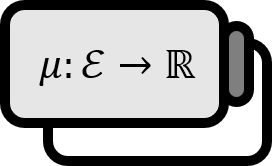Maximal Theorem
Theorem1
For every $f \in L^1_{\mathrm{loc}}$ and every $\alpha >0$, there exists a constant $C>0$ that satisfies the following condition.
$$ \mu \big( \left\{ x\ :\ Hf(x)>\alpha \right\}\big) \le \frac{C}{\alpha} \int |f(y)| dy $$
This inequality is called the Hardy-Littlewood maximal inequality.
The Hardy-Littlewood maximal function
$$ Hf (x) = \sup \limits_{r>0} A_{r} |f|(x) = \sup \limits_{r>0} \frac{1}{\mu \big( B(r,x) \big)}\int_{B(r,x)}|f(y)|dy $$
Proof
Let’s say $E_\alpha =\left\{ x\ |\ Hf(x) > \alpha \right\}$. Then, by the definition of $Hf$, we know that for some $r$, $A_{r} |f|(x) >\alpha$ holds. Let’s fix this $r$ and name it $r_{x}$. Now, let’s say $\mathcal{B}=\left\{ B(r_{x},x)\ |\ x \in E_\alpha\right\}$, $U=\bigcup \nolimits_{B\in \mathcal{B}} B$. Then, $U$ is a cover of $E_\alpha$, therefore $ c < \mu (E_\alpha) \le \mu (U)$.
Let’s say $\mathcal{B}$ is a collection of open balls in $\mathbb{R}^n$. Let’s say $U=\bigcup \limits_ { B\in \mathcal{B}} B$. Then, for some $c <m (U)$, there exists a finite number of disjoint $B_{j} \in \mathcal{B}$ that satisfy the following condition: $$ \sum \limits_ {j=1}^k \mu (B_{j}) >3^{-n} c $$
By the maximal lemma, for each $x_{1},\cdots,x_{k} \in X_\alpha$, there exists a finite number of open balls $B_{j}=B(r_{x_{j}},x_{j})$ that satisfy the following equation:
$$ \sum \limits_{1}^k m (B_{j}) > \frac{1}{3^n}c $$
Now, let’s fix $x_{j}$. Then, the following holds:
$$ A_{r_{x_{j}}}|f|(x_{j})=\frac{1}{m(B_{j})}\int_{B_{j}} |f|(y)dy >\alpha \\ \implies m (B_{j}) < \frac{1}{\alpha} \int_{B_{j}}|f|(y)dy $$
Therefore, we obtain the following:
$$ \begin{align*} c < 3^n \sum \limits_{1}^k m (B_{j}) &\le \frac{3^n}{\alpha} \sum\limits_{1}^k \int_ {B_{j}} |f(y)|dy \\ &\le \frac{3^n}{\alpha}\int_{\mathbb{R}^n}|f(y)|dy \\ &= \frac{3^n}{\alpha} | f|_{L^1} \end{align*} $$
Taking the limit $c \nearrow m (E_\alpha)$ completes the proof.
■
Gerald B. Folland, Real Analysis: Modern Techniques and Their Applications (2nd Edition, 1999), p96 ↩︎
